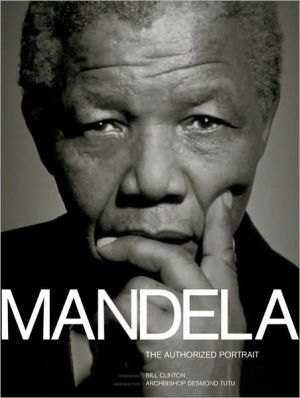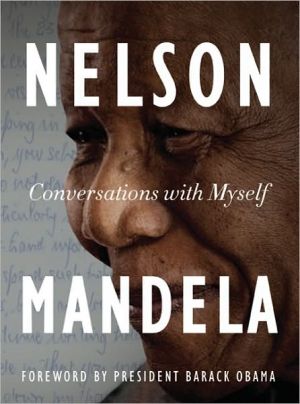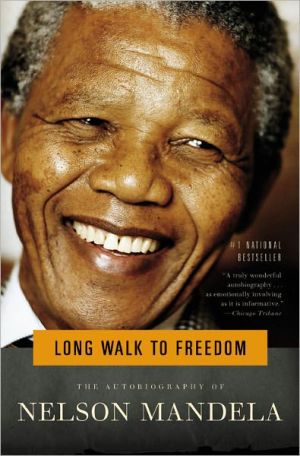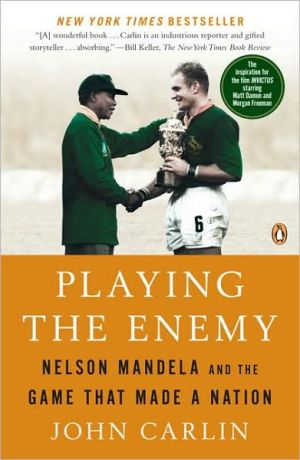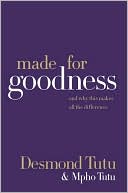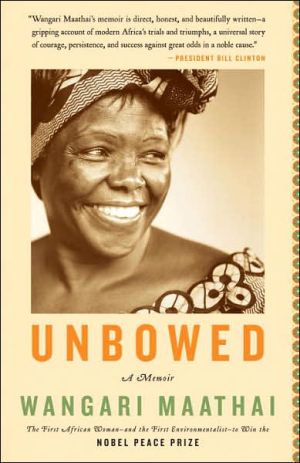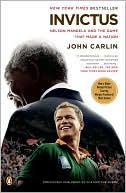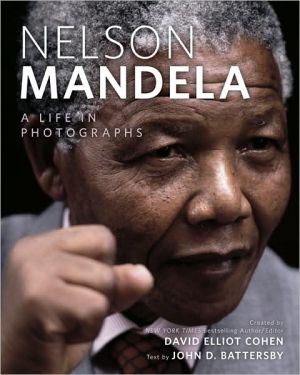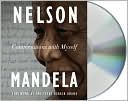Mandela: The Authorized Portrait
'What makes Mandela so special is that he's a real human being. . . . He's got a real life. And the fact that he is so flesh-and-blood real makes his greatness and his sacrifice and his wisdom and his courage in the face of all that has happened to him even more remarkable."-From the foreword by President Bill Clinton\ Named one of Time magazine's 100 Most Important People of the 20th Century, Nelson Rolihlahla Mandela has dedicated his life to fighting racism, segregation, oppression, and...
Search in google:
Named one of Time magazine's 100 Most Important People of the 20th Century, Nelson Rolihlahla Mandela has dedicated his life to fighting racism, segregation, oppression, and exploitation¿and championing democracy, equality, and education.Mandela: The Authorized Portrait celebrates the courage, determination, and remarkable humanity of a great man and chronicles his extraordinary contribution to humankind.Much of the story in Mandela: The Authorized Portrait is told by those whose very lives he has touched. Drawing on 60 original and extensive interviews with family members, close friends, colleagues, and many of the world's leading figures in politics and entertainment, Mandela: The Authorized Portrait tells the inspirational story of an incredible man¿from his birth and early childhood in rural South Africa and his involvement with and eventual leadership of the African National Congress through his 27-year imprisonment and eventual emergence as one of the world's notable leaders and most active agents for change.This richly designed portrait features a foreword by former U.S. president Bill Clinton and an introduction by Archbishop Desmond Tutu. It is illustrated with 250 images and features material taken from private collections as well as the Nelson Mandela Foundation archive¿some of it published here for the first time. Mandela: The Authorized Portrait features artifacts and facsimiles of Mandela's voluminous writings and correspondence¿written records of his negotiations with the prison authorities, intimate letters to his family and friends during his imprisonment, and material from Mandela's personal diaries and calendars.Mandela: The Authorized Portrait is one of the most lavishly illustrated and comprehensive tributes to Nelson Mandela's life and work ever produced. The Washington Post - Glenn Frankel … the narrative text by Mike Nicol is rich and nuanced, the historical documents revealing and the photographs thrilling and evocative. The overhead shot of black South Africans crowding outside the Johannesburg Drill Hall in 1956 for a glimpse of Mandela and other defendants in the original mass Treason Trial is itself worth the price of admission, as is a photo of the open graves for the 69 victims of the 1960 Sharpeville massacre. These images, interspersed among intimate portraits of Mandela, are a reminder that the man and the nation are forever entwined.
\ \ MANDELA\ \ \ THE AUTHORIZED PORTRAIT\ \ \ \ Andrews McMeel Publishing, LLC\ \ \ Copyright © 2006\ \ Nelson R. Mandela\ All right reserved.\ \ ISBN: 0-7407-5572-2\ \ \ \ \ Chapter One\ \ \ At the age of fifty-seven, as he sat in his tiny cell oil Robben Island, Nelson Mandela was to write of the beautiful \ country of rolling hills where he was born. He remembered the rivers and the myriad streams which kept the \ valleys green even in winter. He thought of the majestic Drakensberg mountains to the north and the wild rugged \ coastline of the Indian Ocean to the south. He could smell the musty aroma of the veld. He was serving a \ sentence of life imprisonment; he must have wondered if he would ever see that haunting landscape again. \ While he wrote, a guard paced the corridor, every now and then looking in. Mandela often lent him a copy of\ the Afrikaner weekly Die Huisgenoot, which ensured good relations and deflected attention from what he was\ doing. As the guard returned to his pacing, Mandela would return to Mvezo, a tiny village on the banks of the\ Mbashe River in the district of Umtata in what was then called Transkei.\ Here his mother, Nosekeni Fanny, the third wife of Gadla Hendry Mandela, had her kraal of thatched\ rondavels, her land that she farmed and her livestock that grazed on the communal pastures. "Mvezo," wrote\ Mandela in his autobiography, Long Walk to Freedom, "was a place apart, a tiny precinct removed from the world\ of great events,where life was lived much as it had been for hundreds of years." Here he was born on July 18, 1918. In\ celebration, his father slaughtered a goat and mounted the horns in the house. He named his son Rolihlahla: literally,\ "pulling the branch of a tree," or colloquially, "troublemaker." Although Mandela never believed that a name conveyed\ destiny or that his father glimpsed the future, there would always be a poetic tension between his name and his life.\ This "place apart," Mvezo, was deed in the heartland of Transkei, a vast land between the Cape and Natal, and the\ home of the Xhosa nation. In the nineteenth century it had been designated a "native reserve" after\ bitter wars between the British settlers and the indigenous people had ended in a brooding truce.\ In 1910 the land was absorbed into the Union of South Africa, but the memories of the battles\ and the kings who had stood against the invading forces remained alive whenever the elders sat\ down to tell stories of the past. For Mandela, it was a land as rich in beauty as it was in myth\ and history.\ His ancestral roots were buried in the Thembu people and the Madiba clan. According to\ custom, the line of succession to the Thembu throne passed through the Right Hand House\ while those in the Left Hand House - or Ixhiba - acted as counselors to the rulers of the tribe.\ Although he was a member of the royal household, Mandela was a descendant of the Ixhiba\ house on his father's side, while his mother belonged to the Right Hand House. His father was a respected chief,\ renowned for his strictness and stubbornness, but he was also valued as a counselor and adviser - an unofficial prime\ minister of Thembuland, a custodian of Xhosa history. He could be outspoken and rebellious when faced with situations\ he considered unfair and was not cowed by white authority. These were characteristics Mandela would later come to\ acknowledge in himself.\ About a year after Mandela's birth, his father had a dispute with the local white magistrate and was found guilty of\ insubordination. He was deprived of his chieftainship, losing most of his cattle, land, and income. The family moved to\ a kraal of three rondavels in the nearby village of Qunu where they had the support of relatives and\ friends. It was here that Mandela grew up surrounded by family, running in the veld with his friends, herding\ cattle, moving between his father's wives who were all "mothers" to him, as the Xhosa language has no words for\ stepmother or half-brothers and -sisters. To the mail writing in his cell, his childhood years must have seemed\ idyllic.\ Although Mandela's father never wavered from his traditional religious beliefs, his mother became a Christian and\ had their son baptized a Methodist. The men who officiated at the local Wesleyan church saw promise in the young\ Mandela and suggested that he be educated. As no one in the family, had received formal education, the day that the\ seven-year-old Mandela walked to the single-roomed school on the hill was auspicious. He was wearing a pair of his\ father's trousers that had been cut off at the knee and were tied at the waist with string. "I must have been a comical\ sight, but I have never owned a suit I was prouder to wear than my father's cut-off trousers," Mandela would write\ years later in his island cell. That first day at school Mandela was given the name Nelson by his teacher. Her choice\ of name was probably arbitrary, although at the time mission-educated children were often named after British imperial\ heroes. That an English name was necessary at all had as much to do with the English bias in the education system as\ with the then reluctance or inability of most whites to pronounce African names.\ Two years after he started school, in 1927, Mandela's father died of a lung disease that was undiagnosed but might\ have been tuberculosis. He had been ill for some time and, with prescience, had asked his friend Chief Jongintaba, the\ regent of the Thembu people, to take care of his son. A few days after the funeral, Nosekeni Fanny packed a small tin\ trunk for Mandela and the two of them set out for Mqhekezweni, the regent's Great Place. The quiet, shy boy was taken\ to the small whitewashed rondavel he was to share with Jongintaba's son Justice. Four years his elder, Justice\ was in every way Mandela's opposite: cheerful, outgoing, a sportsman, but also already something of a dandy and a\ playboy. All the same, they were soon firm friends. Equally quickly, the family "adopted" Mandela, calling him\ Tatomkhulu - grandpa - partly because of his serious disposition and partly because they thought he\ looked like an old man.\ Jongintaba was renowned as a powerful and just leader, and a committed Methodist, yet he was also\ steeped in history and tradition. Mqbekezweni was regularly visited by old chiefs and headmen, and the\ stories of the great heroes of Xhosa history, and those of other African nations were constantly in the air.\ This sense of history as a living force and the pervading philosophy of ubuntu, that is "humanness," the\ idea that one's humanity derives from the way in which one interacts with others, entrenched themselves\ in the boy's forming personality. At Mqhekezweni, too, he learned about the coming of the white people\ and the battles that had led to the subjugation of the indigenous peoples they encountered. Jongintaba's\ Great Place was also the judicial center for the region, and it was here that the tribesmen came to express\ their grievances. On many occasions Mandela heard complainants being highly critical of the regent, yet\ always Jongintaba listened without interruption, and, in the end, sought consensus. This was democracy,\ a form of leadership that insisted on everyone's right to be heard, and the regent's self-control and fairness\ greatly impressed his young ward. Many decades later, as president, Mandela would adopt the same\ technique to seek consensus in his cabinet.\ Of equal impact, if lesser importance, to the young boy was the regent's attention to his image. In his\ wardrobes hung a number of suits, and Mandela spent many happy hours pressing creases into the trousers.\ This attention to clothing, however, was not simply one of vanity; it was about dignity and self-worth and\ became a theme that was to resonate\ throughout Mandela's life: during his\ penurious days as a young lawyer, on\ Robben Island, finally manifesting itself\ in the celebratory Madiba shirts that\ became a hallmark of his presidency\ and retirement.\ When Mandela turned sixteen, the\ regent decided it was time for him to\ undergo the circumcision ritual. It was\ a sacred rite of passage that marked the\ end of youth and the beginning of\ manhood, in short, acceptance into\ Xhosa society. Together with twenty-five\ boys led by Justice, he went to a\ secluded lodge in an isolated valley\ through which the Mbashe River\ flowed. In the preparatory days, the\ boys talked, played at stick fighting,\ and, in a symbolic act of daring float in\ earlier times might have involved a\ battle or a cattle raid, stole and\ slaughtered a pig. On the night before\ the ceremony, women from the nearby\ villages came to sing and clap while the\ initiates danced. The next morning the\ boys washed in the river's cold waters,\ wrapped themselves in blankets and\ paraded before the elders and the\ regent. At midday the old incibi appeared with his assegai\ to perform the circumcision. Mandela waited in line,\ tense and anxious. The old man approached and knelt,\ looking into Mandela's eyes. Then, with a single pass of\ the spear's blade, the incibi severed the foreskin. Pain\ burnt through Mandela's veins like fire. For a moment he\ closed his eves, his bead bowed, then he cried out,\ "Ndiyindoda" - "I am a man." There followed a time of\ seclusion in the lodges while the wound healed. The\ initiates painted their bodies with white ochre, symbolizing\ purity. At midnight they buried their foreskins.\ According to custom this was to hide them from wizards\ who might use the flesh for evil purposes. On a sacred\ level, they were burying their youth. Similarly, when the\ seclusion was ended, the lodges were burnt to destroy the\ young men's last links to childhood.\ At the ceremony welcoming them as men, Mandela\ received two heifers and four sheep to honor his new\ status. "I remember walking differently on that day,\ straighter, taller, firmer. I was hopeful, and thinking that\ I might some day have wealth, property and status," he\ wrote in his autobiography. He had a new name too:\ Dalibunga, meaning founder of the council, the bunga\ being the traditional ruling body of the Xhosa.\ Yet on this day of celebration, the main speaker,\ Chief Meligqili, cast a shadow. For the chief reminded\ them that although they might now be men, they had\ neither freedom nor independence while they remained a\ conquered people. At first Mandela felt the chief's\ remarks were wrong and ignorant. Years later he was to\ fight for their truth.\ Not long after his initiation, Mandela was admitted to a highly regarded school, Clarkebury, the oldest\ Wesleyan mission and the biggest educational center in Thembuland. A sheep was slaughtered at the Great\ Place to mark the occasion and Mandela took great delight in a celebration of singing and dancing that was\ solely for his benefit. The next day the regent drove him to the boarding school, cautioning his ward that\ the governor, Reverend Cecil Harris, was closely involved with the local communities and their chiefs and\ should be treated with respect. Intimidated, Mandela was ushered by his patron into the governor's study.\ Harris warmly shook the young man's hand and said he would make arrangements for Mandela to work in\ his garden, as some manual labor after school hours was mandatory. Somewhat in awe, Mandela nodded\ and released the first white hand he had ever shaken.\ He adapted quickly to life at Clarkebury, performing so well in class that he completed the junior\ certificate in two years instead of three. On the playing fields his performance was, by his own admission,\ mediocre, but the hours he spent with Harris and his wife in\ their garden were happy and memorable. Most importantly,\ he came to love gardening and growing vegetables, a pastime\ that would distract him and comfort him during his long\ years of imprisonment.\ Clarkebury, too, opened Mandela to a wider world.\ Among his contemporaries were young people from the\ distant metropolis of Johannesburg, and from other parts of\ the country and the neighboring British protectorate of\ Basutoland (Lesotho). Many of them he found sophisticated\ and cosmopolitan, which made him feel every bit a country\ boy, despite the new boots the regent had given him. Yet he\ was content with his lot. He believed his roots were his\ destiny and his ambition was to fulfill the regent's plans for\ him and become a counselor to the Thembu king. All this\ was soon to change.\ After Clarkebury, Mandela was enrolled at Healdtown,\ a Wesleyan college in Fort Beaufort, some two hundred and\ fifty kilometers from the regent's Great Place. The town's\ name resonated with the battles that had been fought\ between the British settlers and the Xhosa in the previous\ century, and the Victorian college buildings covered in ivy spoke of a "privileged academic oasis" to the\ young man. Once again the education was uncompromisingly British and flavored with a Methodist bias.\ However, while the religious tenets did not move Mandela, he was influenced by the strict ethical standards\ of the Wesleyans and their mental discipline of honing an idea to its essential ingredients. Both these\ elements, and the self-reliance demanded by life at a boarding school, went to fortify a character that was\ already principled and stubborn.\ Healdtown further broadened Mandela's horizons. He became friendly with Zachariah Molete, a\ Sotho, which struck him as "quite bold" as he was venturing beyond the tribe. He witnessed a black\ housemaster stand up to the white principal and realized that white authority could be challenged. In his\ final year, Krune Mqhayi, a Xhosa praise singer resplendent in a leopard-skin kaross, matching hat, and\ wielding assegais in each hand, came to recount a poem that eulogized the Xhosa as a proud and powerful\ people. The poet's performance was electrifying: the themes of African unity excited Mandela, but, equally,\ so did the strident nationalism.\ After graduating from Healdtown in 1938, Mandela went on to Fort Hare, the only black university\ in South Africa, and the alma mater of the revolution to come. He was twenty-one years old and dapper\ and confident in a grey double-breasted suit bought for him by the regent. For Mandela and his\ contemporaries, the university was at once Oxford and Cambridge, Harvard and Yale. It had been\ established in 1916 by white missionaries and black educationalists and was the focal point of the black\ intelligentsia. Nevertheless, it remained a small college of one hundred and fifty students, only a handful\ of whom were women. In his first year Mandela studied English, anthropology, politics, native administration,\ and Roman Dutch law. He took to the sports fields, excelling in the long-distance running and\ boxing he had taken up at Healdtown. Team sports were not Mandela's forte: he was a loner, in many ways\ self-dependent.\ Among the first people he befriended was Kaiser (K. D.) Matanzima, actually his nephew from the\ Thembu royal family although K. D. was four years older. Unlike Mandela, Isis line descended through the\ Right Hand House and he was destined to be a king or paramount chief. Mandela hero-worshiped him\ and the two became inseparable. In fact, K. D. even shared his allowance with the younger man as the\ regent did not believe in sending his ward pocket money. Despite their friendship and Mandela's\ admiration for K. D., politics would drive them apart as Matanzima's later alliances with the apartheid\ government drew him into the Bantustan policy of separate homelands for blacks. When Transkei was\ declared self-governing in 1963, Matanzima became its chief minister. However, Mandela would always\ acknowledge that K. D. had once been his idol.\ Many of Mandela's friends at Fort Hare were already politically active and, in\ some cases, members of the African National Congress (ANC). Invariably they\ were far more politically astute than the self-styled country boy. It was at Fort Hare\ that he first encountered Oliver Tambo with whom he was to form Isis legendary\ friendship. They met while teaching Bible classes in neighboring villages and the\ somewhat reserved young man impressed Mandela with his intelligence, his\ scholarship, and his expertise as a political debater.\ Perhaps unsurprisingly given Mandela's ideas about fairness and democracy,\ the first incident that moved him into the political arena concerned his\ house committee. As there were no freshmen represented on the body, Mandela\ led a referendum to reconstitute the committee along more equitable lines. He\ and his cohorts were duly elected, much to the chagrin of one of the seniors\ who laid an official complaint. The warden of the college was called in to\ mediate but decided against intervening. "This was one of my first battles with\ authority, and I felt the sense of power that comes from having right and justice\ on one's side," the prisoner would write many years later on Robben Island.\ (Continues...)\ \ \ \ \ \ \ \ Excerpted from MANDELA\ \ Copyright © 2006 by Nelson R. Mandela.\ Excerpted by permission.\ All rights reserved. No part of this excerpt may be reproduced or reprinted without permission in writing from the publisher.\ Excerpts are provided by Dial-A-Book Inc. solely for the personal use of visitors to this web site.\ \
\ From Barnes & NobleCreated by a team of award-winning writers, photographers, and researchers, Mandela: The Authorized Portrait vividly captures the momentous life of Nelson Rolihlahla Mandela. This large-format, fully authorized volume traces Mandela's inspiring life: his childhood in rural South Africa through his politicalization and subsequent leadership in the African National Congress; his 27-year imprisonment on Robben Island; his release and election as South Africa's first truly democratically elected president. A celebration of a true epoch-maker.\ \ \ \ \ Glenn Frankel… the narrative text by Mike Nicol is rich and nuanced, the historical documents revealing and the photographs thrilling and evocative. The overhead shot of black South Africans crowding outside the Johannesburg Drill Hall in 1956 for a glimpse of Mandela and other defendants in the original mass Treason Trial is itself worth the price of admission, as is a photo of the open graves for the 69 victims of the 1960 Sharpeville massacre. These images, interspersed among intimate portraits of Mandela, are a reminder that the man and the nation are forever entwined.\ — The Washington Post\ \
